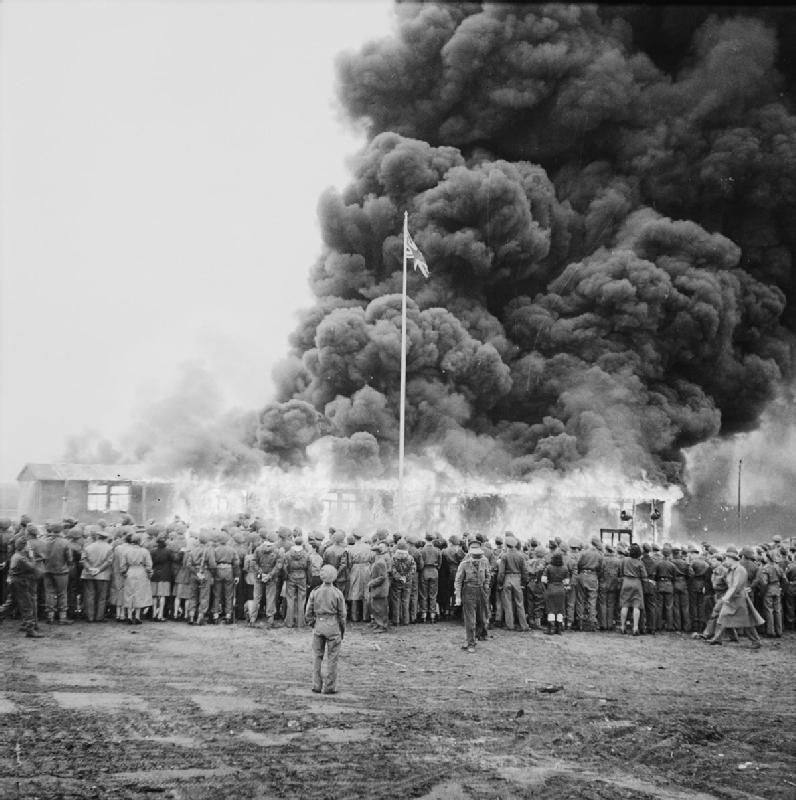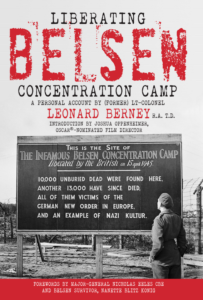Liberating Belsen: ‘I know what Nazism did: I was there’
This blog has been written by John Wood, the son of a soldier who was among the troops who entered Bergen-Belsen on 15 April 1945, to mark the 70th anniversary of the camp's liberation.

This blog has been written by John Wood, the son of a soldier who was among the troops who entered Bergen-Belsen on 15 April 1945, to mark the 70th anniversary of the camp’s liberation.
It must have been in the late 1970s that my father Leonard Berney, a former senior British Army officer, first told me of the part he played in the liberation of Belsen. Some 35 years later, he decided to turn his account of the camp’s liberation into a book and he asked me if I would like to be its editor. I was honoured to have this responsibility bestowed upon me, and I hope I have done it justice.
One of the reasons he wanted to write the book was to help ensure future generations know the truth about the Holocaust. If there’s one thing he can’t stand, it’s Holocaust deniers:
‘In the last few years I have become aware that there were people in the UK and elsewhere who deny that the Holocaust ever happened; they assert that it is all a lie. It is not a lie. I know what Nazism did: I was there!‘I have always thought it important to do what I could to inform the younger generation that the Holocaust did happen, and to remind them of the events of the 1930s and how easily a democratic government can become a dictatorship if the citizens of that country allow that to happen. Over recent years I have written several articles and given lectures, and now I present this book about my experience at the Bergen-Belsen concentration camp.’
Being the son of a Belsen liberator certainly has been eventful. I attended the 1995 commemoration of the liberation of Belsen in Hyde Park, London. There I met Lord Greville Janner, who also served with my father at Belsen, as well as Norman Turgel who was with the British Intelligence Corps – both of whom remembered my father from 1945. In fact, Norman even told me that my father was instrumental in helping Norman and Gena, a Belsen survivor, stay in touch with each other after Norman had to return to the UK. They later married.
Since then, my father has given talks about the liberation and has appeared in numerous TV news reports and documentaries about the Holocaust – most notably Night Will Fall. He has also given many talks on liberating the camp, including at the University of Greenwich, London, and Congregation Ner Tamid, Las Vegas.
As my father’s ‘agent’, I regularly receive requests to get access to him for interview and the like. A year or so ago, I received an email from the daughter of a Belsen survivor who explained that her mother had told her all these years how a British officer called Leonard Berney saved her life in Belsen. The Belsen survivor in question was Nanette Blitz Konig, a former classmate of Anne Frank. The story attracted a lot of media attention. I almost feel I am now a part of Nanette’s family.
 Liberating Belsen Concentration Camp is the only book to be published that recounts the events leading up to the British Army’s uncovering of the concentration camp and its 60,000 prisoners, how the Army dealt with the unprecedented horror that existed in the camp, how the surviving prisoners were rescued, how the inmates were evacuated, how the Royal Army Medical Corps established the world’s largest hospital to care for the many thousands of sick and emaciated ex-inmates, how the survivors were rehabilitated and cared for, how they were repatriated to their own countries, and why many thousand refused to return ‘home’ and the eventual establishment of the Belsen displaced persons camp, the largest camp of its kind in Germany.
Liberating Belsen Concentration Camp is the only book to be published that recounts the events leading up to the British Army’s uncovering of the concentration camp and its 60,000 prisoners, how the Army dealt with the unprecedented horror that existed in the camp, how the surviving prisoners were rescued, how the inmates were evacuated, how the Royal Army Medical Corps established the world’s largest hospital to care for the many thousands of sick and emaciated ex-inmates, how the survivors were rehabilitated and cared for, how they were repatriated to their own countries, and why many thousand refused to return ‘home’ and the eventual establishment of the Belsen displaced persons camp, the largest camp of its kind in Germany.
My father was in charge of evacuating the ex-prisoners to the vast rehabilitation camp the Army set up. He was then appointed as the commandant of the camp until its management was handed over to the United Nations, and he gave evidence against the SS guards at the Belsen war crimes trials.
One detail of Belsen that is largely unknown is that the hospital in which many of the survivors were treated, a former German Panzer barracks, was the largest hospital that has ever existed complete with 15,000 beds. The book reads:
‘A British Army field hospital, an Army Field Ambulance Unit and two Casualty Clearing Units had been taken out of the line and ordered to Belsen. They began converting about half of the Panzer Barracks into a vast hospital. Halls and dormitories were turned into hospital wards. Military Government gave orders to the mayors of the towns and villages surrounding the camp that all homes, shops and clinics were to hand over all spare beds, blankets, medicines, surgical equipment and men’s and women’s clothing. These were collected in the Regiment’s trucks. Other men from the Regiment rounded up all the civilian German nurses and doctors they could find and brought them to work at the Panzer Barracks hospital. In addition, German Army doctors held in our prisoner-of-war camps were collected and brought to Belsen.’Typhus is carried by lice; the great fear was of bringing typhus from the concentration camp into the new hospital we were creating. A ‘human laundry’ was set up in the stables of the barracks—when the sick inmates arrived at the hospital, they were to be thoroughly washed and deloused before entering the wards. This ‘human laundry’ would be staffed by German Army doctors and nurses transferred from the Panzer Barracks hospital, working under British Army supervision.’On 21st April, six days after liberation, the newly created hospital was ready to receive its first patients from the concentration camp. A remarkable achievement! The records show that by the time the concentration camp was emptied, between 14,000 and 15,000 patients were admitted and treated there—the largest hospital in the world, before or since!’
The book Liberating Belsen Concentration Camp – A personal account by (Former) Lt-Colonel Leonard Berney R.A. T.D. has been released today (15 April 2015) to mark the 70th anniversary of the liberation of Bergen-Belsen. It is available from Amazon.
The HMDT blog highlights topics relevant to our work in Holocaust and genocide education and commemoration. We hear from a variety of guest contributors who provide a range of personal perspectives on issues relevant to them, including those who have experienced state-sponsored persecution and genocide. The views expressed are those of the author and do not necessarily represent the views of HMDT.